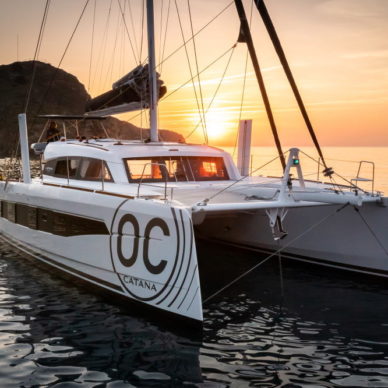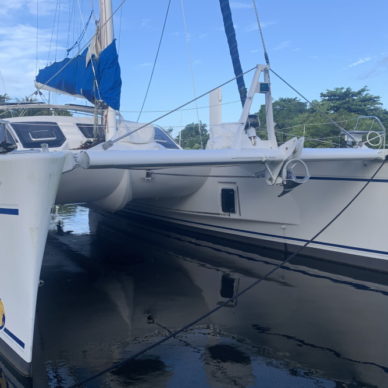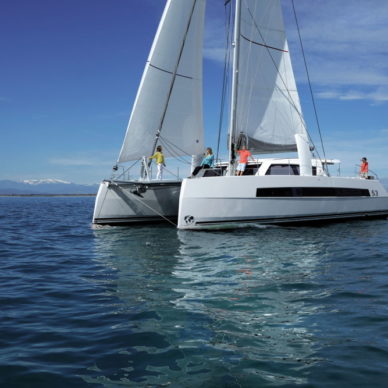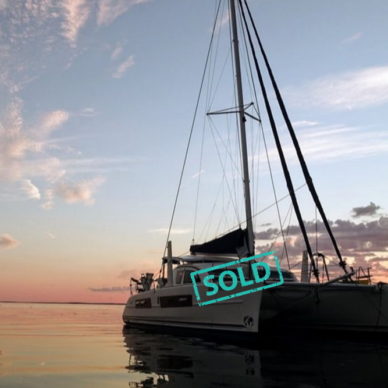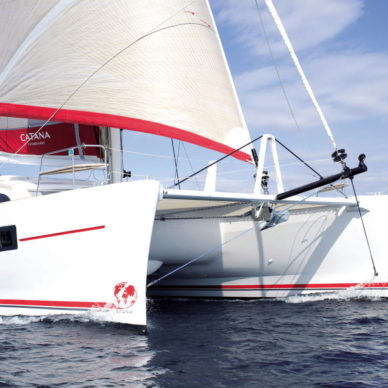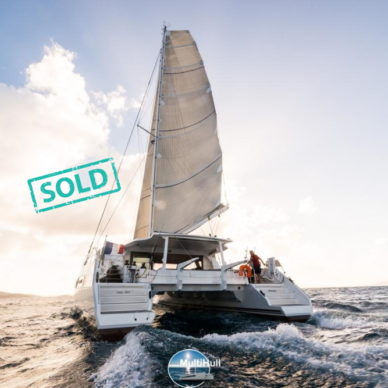Catana Catamarans
Catana began building catamarans in 1984 thanks to two sailing enthusiasts: Jean-Pierre Prade and Thierry Goyard. They began building in Cogolin in the South of France. The company is now based in Canet-en-Roussillon, France. This article covers the history of this famous multihull yard.
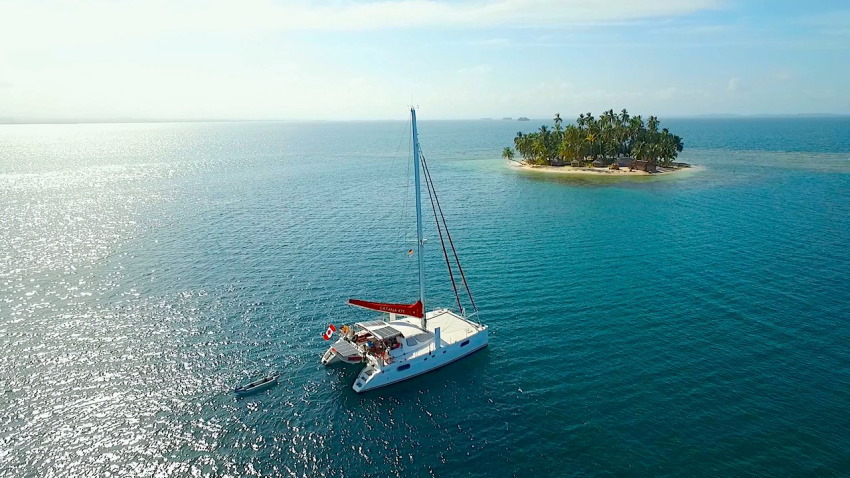
Crowther’s Cats
In their early years, Catana became the world leader in fast-performance cruising catamarans helped by legendary Australian multihull designer Lock Crowther. Following the Crowther era, Christophe Barreau and Frédéric Neuman continued the success with a series of designs that remain popular to this day.
Like Nautitech catamarans, they favoured a more exposed helm position aft for maximum sailing feel – the sporty (monohull) set-up , if you like. The latest model (the Ocean Class 50) has a raised starboard helm.
The two original partners of Catana employed Lock Crowther to design a range of models from 38′ to 48′. The two directors (Goyard and Prade), both engineers, sailed for several years on multihulls, including a round trip to Greenland, on a Lock Crowther design of course.
Later, a young architect called Christophe Barreau started working with Lockie on the deck & interior. The 411 design was credited to both men.
From Cogolin to Canet en Roussillon
From 1984 to 1993, the Catana yard in Cogolin built around five to seven boats per year. In 1986 they started using Twaron for the inner skin of the shell.
Catana moved to Canet en Roussillon in 1998 and the company was sold in 2000 to a group of investors. Prade left the boat business, but some years later Goyard opened XL Catamarans, also in Canet, selling high-performance catamarans (the TS50/TS52) designed by Barreau.
The Marsaudon Connection
Before shutting up shop at XL Catamarans, Goyard commissioned Barreau to design the TS42 (now built by Marsaudon Composites in Lorient and one of the fastest 40′ performance cruising cats on the water. Marsaudon had collaborated with Catana previously on the 521/522- they built a dozen of them under contract.
Barreau’s Boats
Hull #1 of the C411 (now Pelagic) was the first model credited to Barreau, but Crowther’s name also pops up on this design. Crowther was probably retained as a consultant with Christophe Barreau taking the lead.
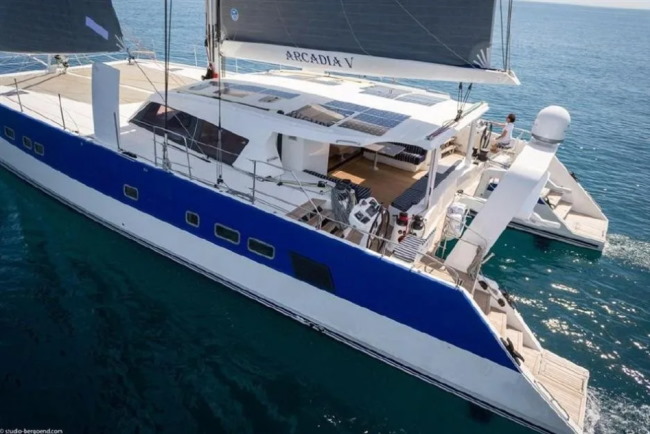 The 70 – Designed by Marc Lombard. Image credit Studio Bergoend
The 70 – Designed by Marc Lombard. Image credit Studio Bergoend
Barreau continued to develop the design DNA started by his mentor with asymmetrical hulls, tulip-shaped bows, a narrow waterline, and daggerboards for upwind sailing.
Lombard Advises
More recently, Catana set up an in-house design studio and worked with the Marc Lombard Group as a consultant (another of my favourite multihull design teams and known for its Nautitech, Neel and Privilege designs).
Lombard is credited with designing the Catana 70, after which they brought the designs in-house, but you can still spot his influence in the shapes of the hulls.
Carbon Infusion Technology
Catana remains a world specialist in fast cruising catamarans ranging from 42 to 90 feet, all designed for long-distance cruising and continues to be unique in that it builds boats using their Carbon-Infusion and Twaron processes.
The hulls, bulkheads, deck and furniture are all built in foam-cored sandwich, which make Catana Catamarans light and fast. Recent models have veered away from the super fast, light cats of their early years (Marsaudon have moved into this space), but they are no slouches particularly when the wind picks up.
Performance and Safety
Catana focuses on producing fast, comfortable ocean crossers. Their yachts are above average on the performance front, though not as quick as others in lighter winds. It’s a segment of the market that is getting more competitive: HH for example has launched its OC50 catamaran which sits in this space.
The latest design is the Ocean Class, a 52-footer that launched in 2020 with a single raised bulkhead helm.
The History of Catana- a Timeline
- 1984: Catana is founded in Cogolin, France.
- 1984 Catana 40C
- 1988 40S (until ’92)
- 1989 Catana 37 (until ´91), 39 (until 94), 42S, 46 (until ´90)
- 1991 Catana 47 (Crowther), Catana 48 (8 units built until ´96)
- 1992 Catana 44, 48R (2)
- 1994: Catana 411
- 1995 Catana 381
- 1996 Catana 531
- 1997: Catana opens in Canet-en-Rousillon and launches the legendary 471. Also Catana 611.
- 1998 Catana 431 launched followed by the 432. Also Catana 721
- 1998 Bruno Nicoletti completes the Vito Dumas circumnavigation on his Catana 44: Brumas Patagonia.
- Catana 45 One Off (custom Barreau project)
- 1999: they launched the Catana 401 which replaced the 381 and 411 (later also built by Phisa as the 42)
- 2000 Catana Aikane 56 (VPLP design)
- 2000: the 472 and 581 are launched: these both have more luxurious specs than earlier boats.
- 2001: launch of the 582, a luxury performance cruiser, later marketed as 58 Ocean Class
- 2002: the Catana 52 is launched, eg 521, 522 then Ocean Class
- 2003 Last 471 produced in May #68 “Element”.
- 2003 Catana was bought by Poncin. They market the 47-footer as the 47 Ocean Class up to 2007
- 2004 Catana 43 Ocean Class (evolved from 431), 47 Ocean Class
- 2006: Catana began to manufacture larger yachts from 82 to 90 feet long.
- 2007 The Catana 50 Ocean Class is launched
- 2008 Catana 41 Ocean Class, 65 ,Catana 90
- 2010: launch of the Catana 42 and a lighter 50.
- 2011: launch of the Catana 47 and 59.
- 2012: The Catana 70 is launched
- 2013 Catana 55
- 2016 Catana 62
- 2017 Catana 53 launched at La Grande Motte.
- 2020 Catana launches the Ocean Class, a 52-footer with a single raised helm station on the starboard bulkhead.
Models
(Sorted by Year)
Catana 40, 40S (1984-92)
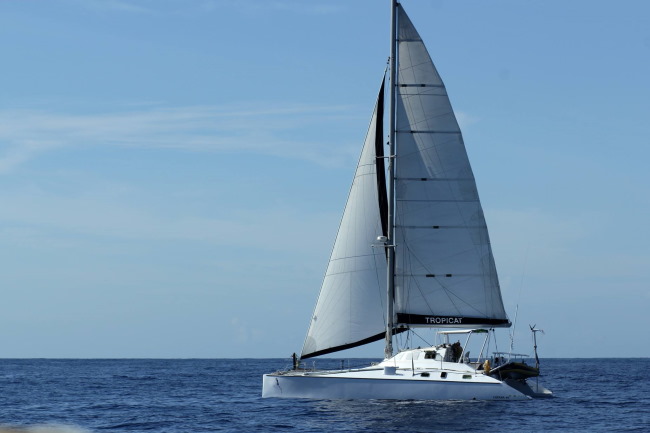
The Catana 40 was the very first model launched in 1984 when Catana was based in Cogolin in the South of France.
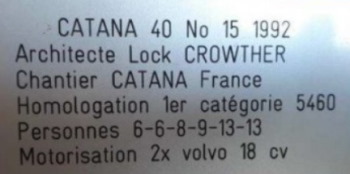 This classic catamaran, designed by Australian architect Lock Crowther, set the DNA of the brand. The boat was not a huge commercial success: only 16 examples were built, but it set the template for the future success of this performance catamaran brand. Currently, there are only 11 or 12 Catana 40s afloat.
This classic catamaran, designed by Australian architect Lock Crowther, set the DNA of the brand. The boat was not a huge commercial success: only 16 examples were built, but it set the template for the future success of this performance catamaran brand. Currently, there are only 11 or 12 Catana 40s afloat.
Hull #1 was called “Pêcheur de Lune” (Moon Fisherman). The first owners registered her on 25th July 1985 in Toulon. In 2019, she was restored by Alberto Machado and renamed “Oceanus”
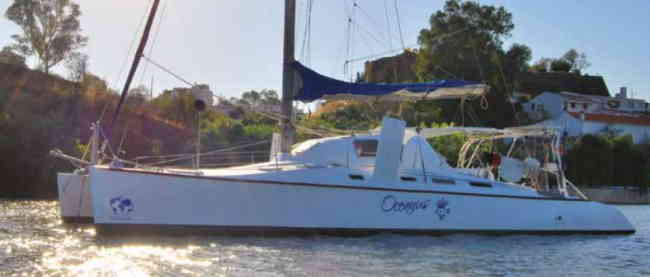
There are 2 versions, the 40C (11 built? Hull #11 was launched in 1988) and the 40S. The plate above is from a 40S (Hull #15, 1995).
Fast Cat
This cat is quick! She weighs only 5.8 tonnes, meaning she sails well even in light winds. The bridgedeck was high for the time, so there was less slamming compared to the cruising cats of the time such as the Prout range.
And upwind, with her fine hulls and daggerboards, she was a real performer.
There’s not much space on her compared to modern cats, but the owners didn’t care as they were flying along.
Even so, she came with four double cabins- the limited space was well thought out: an excellent design that is very rare on the second-hand market.
Later Came the 40S
The later 40S was built with a C39 deck mold and a 42 cockpit mold spliced together. An example is “Avighna” (1992) Hull #16.
The 40S has a narrower beam than the original 40C models which became the 42.
Catana 42S (1988?)
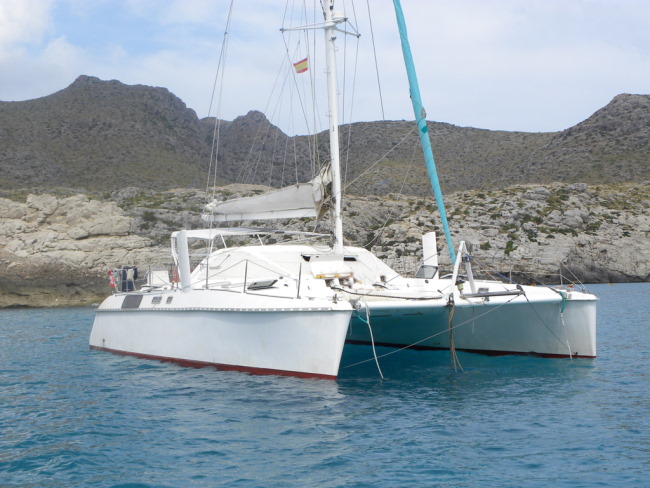
Another Lock Crowther creation, the Catana 42S was slightly longer and sleeker than the original 40C developed from the same moulds I believe. A lovely looking catamaran, especially from this angle. Around 20 were made.
An example is “Paikea“, a 1990 42S.
Catana 37 (1989)
The smallest Catana, but pretty rare…
Catana 39 (1988)
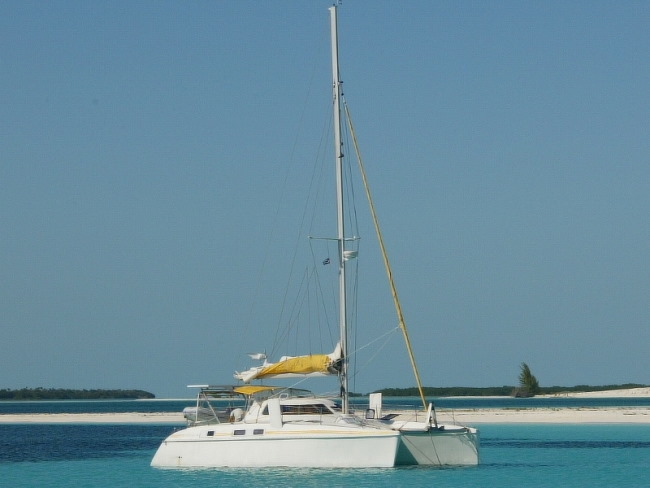
Image Credit: Twilight (1993)
Another example is Tigre, a Catana 39S, hull #4.
Catana 44 (1992)
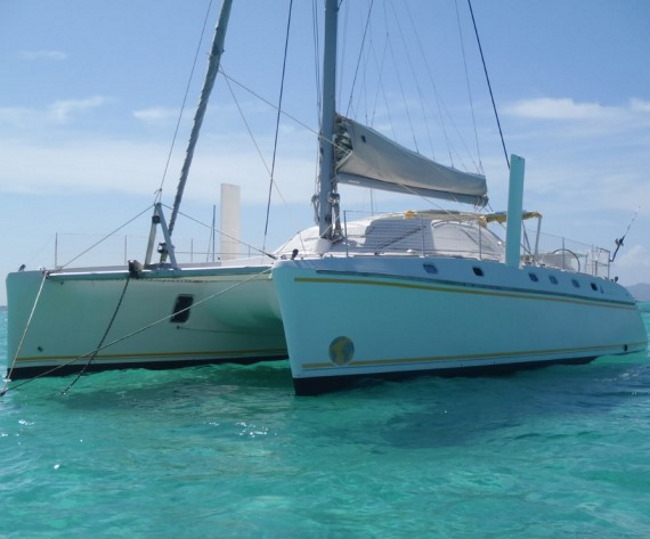
Another popular Lock Crowther design from Catana’s early days. This yacht evolved from the 42. A new wider hull mould was made using the same deck mould and that became the 44.
The 44 design was later lengthened and became the 48.
An example is S/V Pacific Hoodlum #10 (1994), a Catana 44S. Bruno Nicoletti famously completed a “Vito Dumas” circumnavigation on his Catana 44 named “Brumas Patagonia”.
Catana 48 (1992)
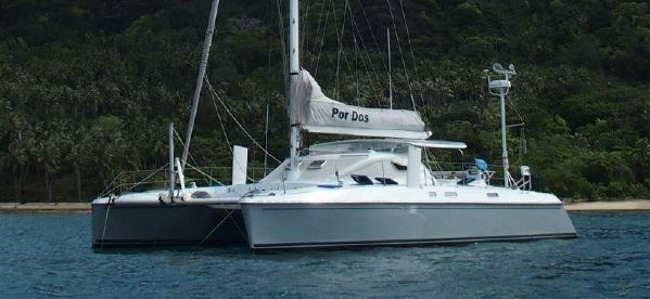 Image credit: Por Dos
Image credit: Por Dos
The 48 is probably the most sought-after of Lock Crowther’s early Catana designs. She has a much lower bridge deck than more modern Catanas but has a high power-to-weight ratio – she’s a fast cat.
The Catana 48 is a modified 44 with transom extensions and a bigger rig.
They also built two Catana 48Rs (Racing) which were stretched 42s and different from the standard 48s.
There were only eight 48s produced. I am not sure whether this number includes the 48Rs. Hull #8 was launched in 1996.
Catana 411 (1994)
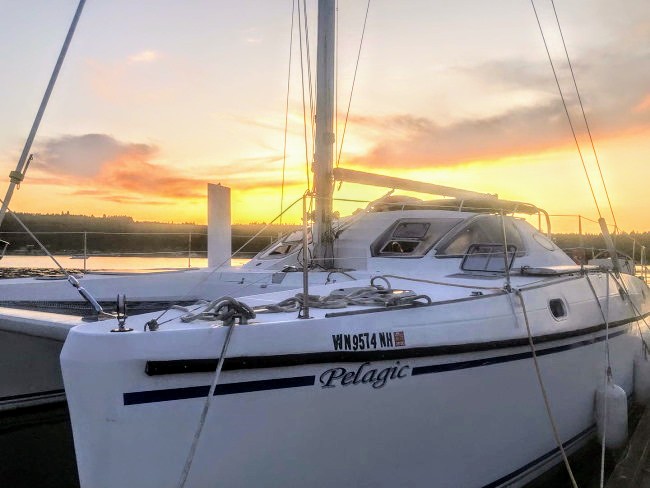 Photo Credit: Chasing the Hook
Photo Credit: Chasing the Hook
The 411 design was credited to both Lock Crowther and Barreau. Shown is Pelagic, the #1 hull. The deck mold was hand-built and the boat was transported to the Paris Boat Show where it had to be sold to keep Catana afloat.
There were 29 411s built. Hull #29 (Darbrook) was built in 1999
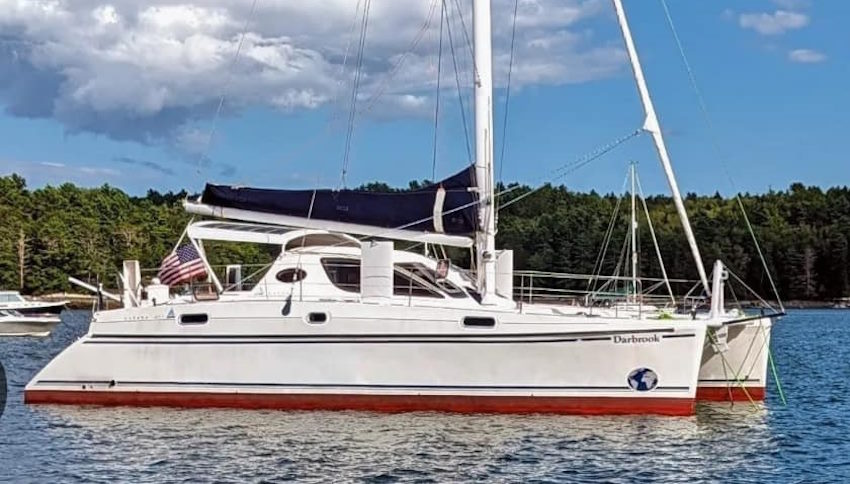
Catana 381 (1995)
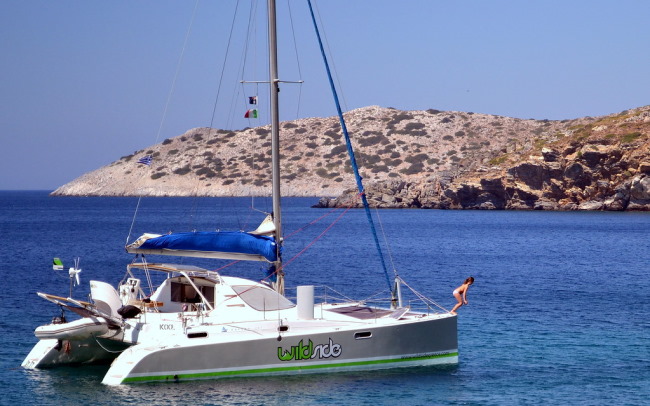 Image Credit: Wildside, Greece
Image Credit: Wildside, Greece
This is a quirky cat and Catana’s smallest. The big story is the aft central helm. I love it, they don’t make them like this anymore! I believe this model went up to hull #23. So, if someone tells you that Catana used to be famous for their twin aft hulls, you can put them right with this model.
Catana 531 (1996)
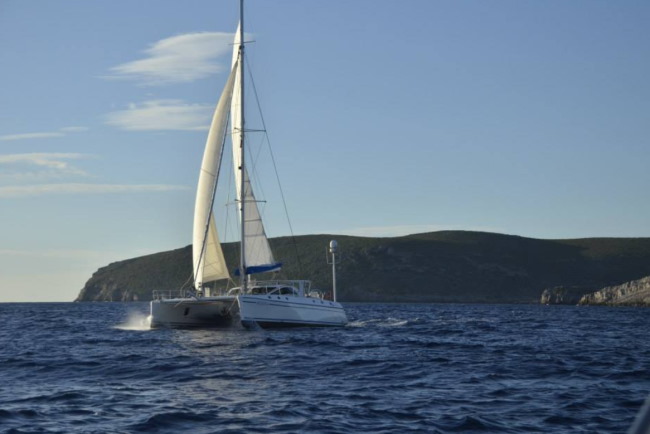
A Real Looker
A large, powerful catamaran from Catana’s earlier days (90s). These boats remind me a bit of the early Lagoons – they are sleek. Nice looking cats.
Catana 471 (1997), 47 Ocean Class (2003)
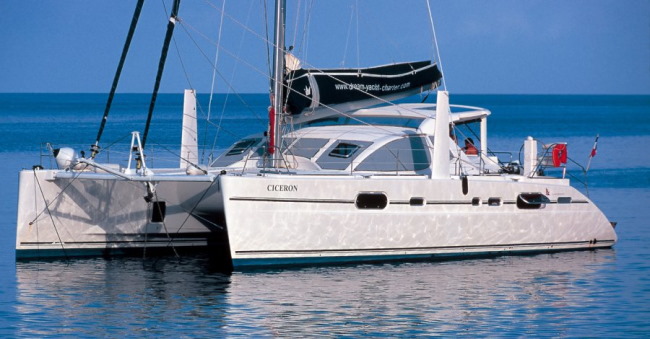 Image Credit: Dream Yacht Charter.
Image Credit: Dream Yacht Charter.
With the launch of the 471, the Barreau/Neuman design partnership started to motor. This is one of my favourite Catana designs, they nailed it with this one. An example is “Our White Magic” (2002). Hull #45.
Another example is S/V Scenic Route #64
The last Catana 471 hull (#68) named “Element” was delivered in May of 2003. Then this model was marketed as the 47 Ocean Class until 2007.
The 471 is the best-selling Catana model to date and voted “Boat of the Year” in 1999 in the US.
Read our full Catana 471 review.
Catana 611 (1997)
Catana 431, 432 (1998),
43 Ocean Class ( from 2003)
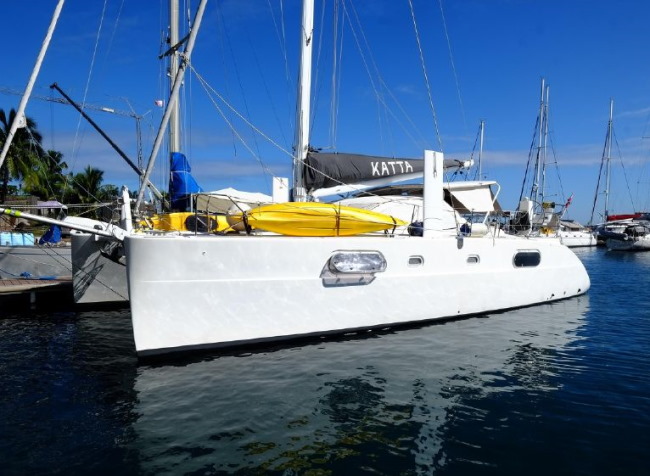 Image credit: Katta
Image credit: Katta
Launched as a kind of ‘mini 471’, the 431 shares many of the same design characteristics as the bigger boat. The Barreau Neuman team was finding their feet with these designs. A great balance between performance and comfort.
 Nice Lines
Nice Lines
Like the 471, she is a very pretty design, well proportioned and remains very popular on the second-hand market.
431 hull #54 Papillon, for example, was delivered in June 2003 with an Alucarbon mast. Other examples are S/V Icaros #48 (2002) and Rizkitt #10 (1999).
After the purchase of Catana by Poncin in 2003, this model was sold as the 43 Ocean Class.
Catana 721 (1998)
Catana 401 (1999)
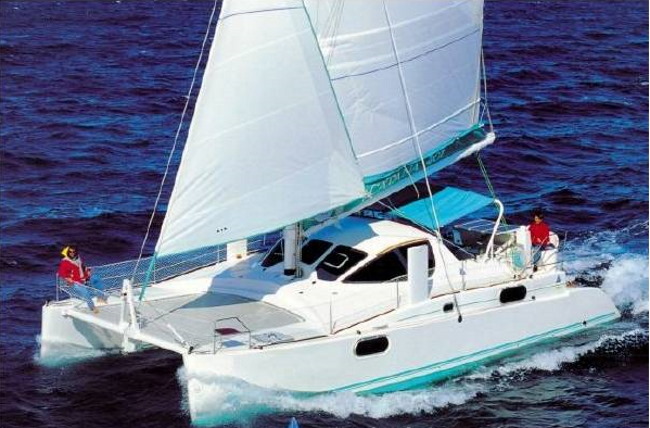 Catana 401
Catana 401
The Catana 401 replaced the 381 and 411. These are very popular boats. The 401 was an updated 381 with a new cockpit mould from the cockpit bulkhead aft.
When Catana stopped production of the 401, they sold the moulds to Phisa, which lengthened them, made some other changes and sold it as the Phisa 42. They are worth a look, as the interior finish was upgraded on the Phisa.
Catana 472 (2000)
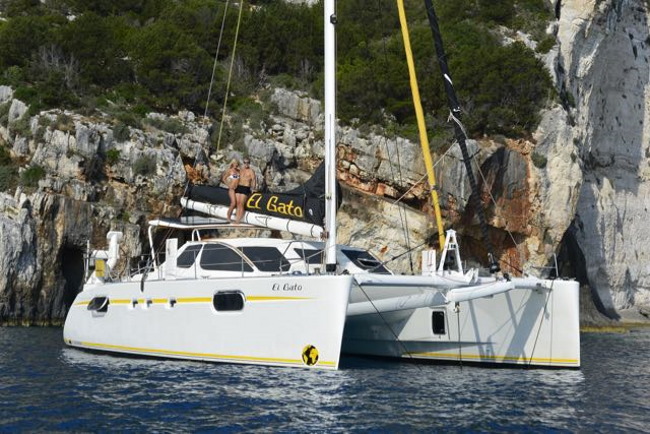
The 472 is a higher-spec version of the 471. Shown above is “El Gato”. Aesthetically, Catana hit top marks with these boats
Catana Aikane 56 (2000)
This 56-footer was designed by VPLP
Catana 581/582 (2000/2001)
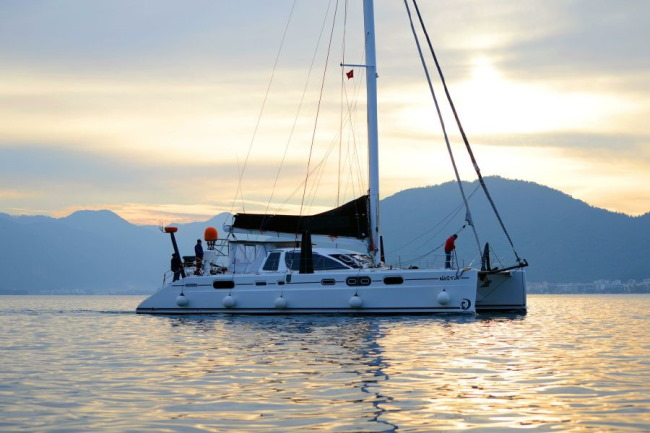
Incorporating all of the design features that made these Christophe Barreau Catanas so sought after. This is a high-end performance cruising catamaran with narrow hulls, a high bridgedeck clearance, minimal weight forward of the mast, and high-aspect daggerboards instead of low-aspect keels.
You will struggle to find a better long-distance blue water cruiser than this boat.
Catana 521, 522 (2002)
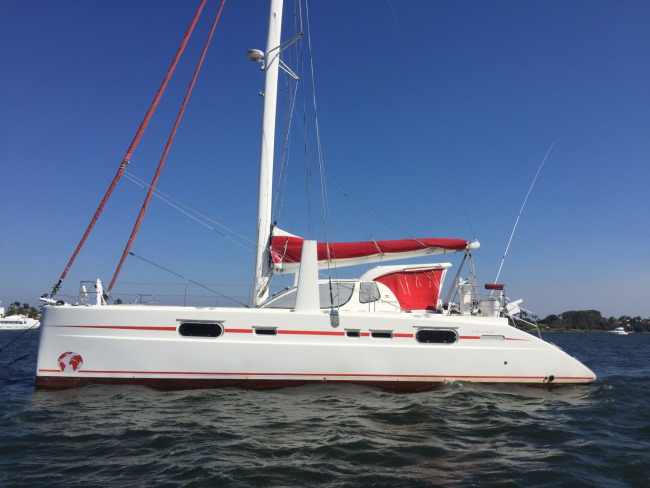
Another Barreau/Neuman design from their “Purple Patch” years. If you are looking for a bigger version of the legendary 471, this is it. Marsaudon built a dozen of these fast cats under contract. They look like they could weather a storm, don’t they?
The Marsaudon Connection
The last one was built in 2005: “Chaton”- this is a very fast boat with a carbon mast, that averages between 220 and 240 miles on longer passages: a true luxury performance cat. Another example is “O2” which was built by Dominique Marsaudon in Lorient in 2003.
Catana 50 (2006)
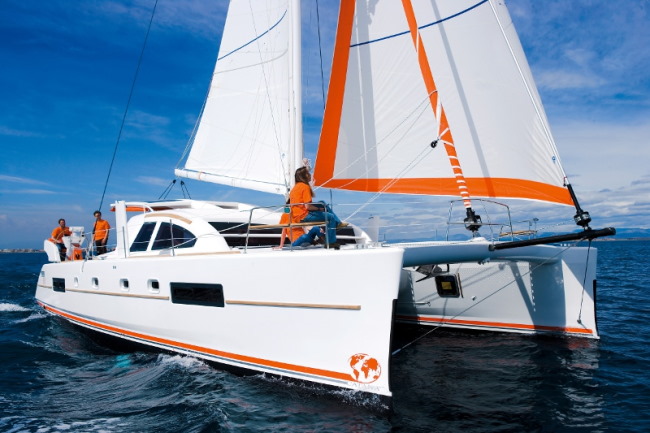
Catana went through some financial difficulties after the dot com crash in the early noughties, but they came roaring back with the Catana 50. This cat was well received thanks to its stable ride through the waves. The defining feature was that bulbous bow: a wave-piercing profile that minimised hobby-horsing and provided extra buoyancy.
The Catana 50’s boards are angled slightly inward to maximize lift under sail- she performs well upwind.
Catana 41 Ocean Class (2008)
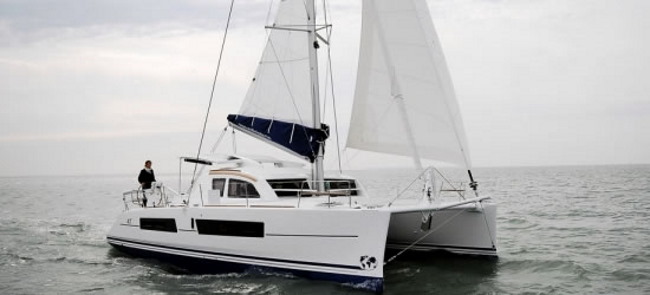 This is the #1 hull, “Piratical”. Built in 2007 but launched in 2008.
This is the #1 hull, “Piratical”. Built in 2007 but launched in 2008.
This is very similar to the newer 42. The saloon layout is different from the later boat with the galley port forward.
Catana 65 (2008)
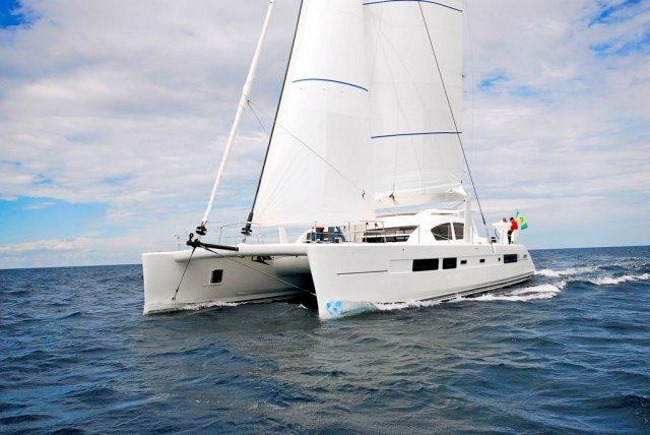
The 65 was one of the last Christophe Barreau designs for Catana. They were making some big catamarans at this point.
Catana 90 (2008)
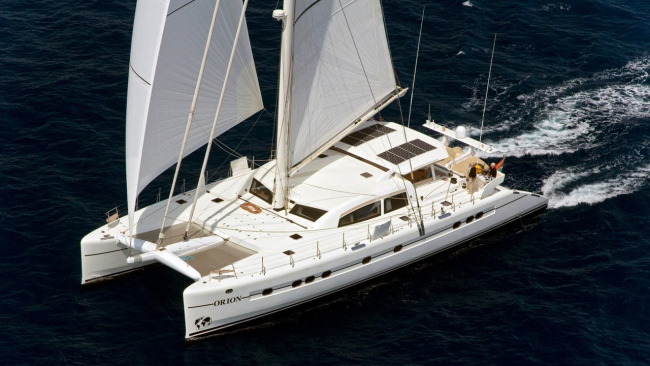
The largest yacht that the shipyard has constructed is the Catana 90, like the example above, Orion. This is a sleek looker despite its length.
Catana 42 (2010)
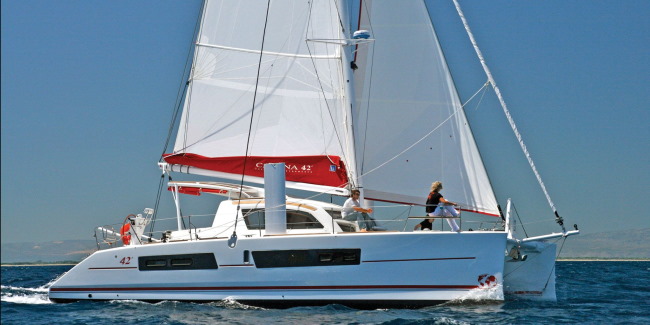
The 42 is an updated version of the 41 that was launched 2 years earlier. The galley was moved to the aft of the salon and they improved some of the sail handling. Then they renamed her the 42, maybe in honour of that great early Lock Crowther design?
The 42 was named “Boat of the Year” in the US in 2014.
Catana 82 (2010)
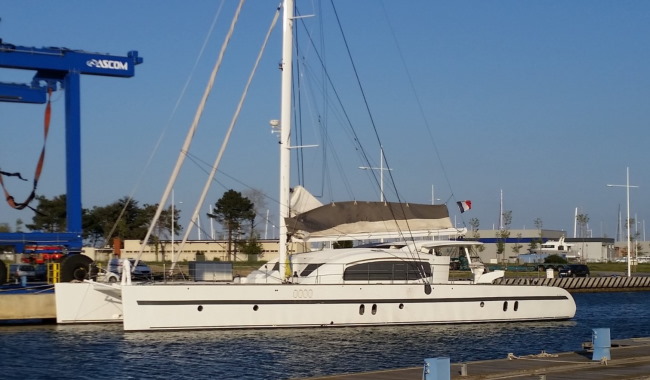
Launched from Catana’s large yachts division that was set up in 2006. The 82 is not the prettiest in the range (in my opinion, I am sure the owner would disagree). For me, it looks like they just stretched the smaller boats.
Catana 47 (2011)
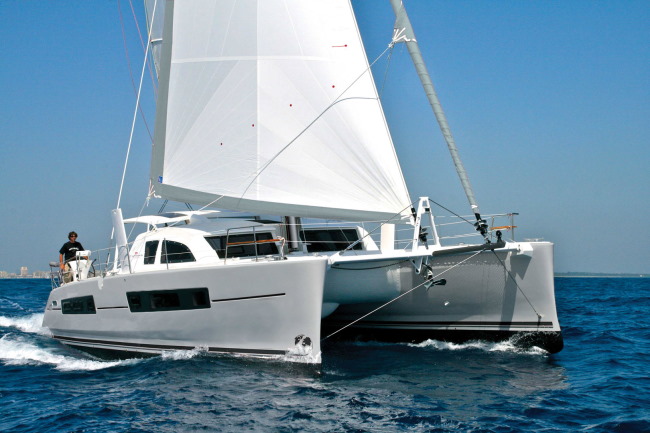 Image Credit catana.com
Image Credit catana.com
The 47 is no longer part of Catana’s current line-up. We were hoping for her to get the new look like the 53, but the yard has moved direction to the newer Ocean Class range with a bulkhead helm. They seem to be moving more towards the comfort end of the spectrum, probably influenced by the success of the Bali range.
She is a very solid, seaworthy catamaran that is infused with carbon, and evolved from the 471 but doesn’t look as pretty.
Read our full Catana 47 review in the performance catamarans section.
Catana 59 (2011)
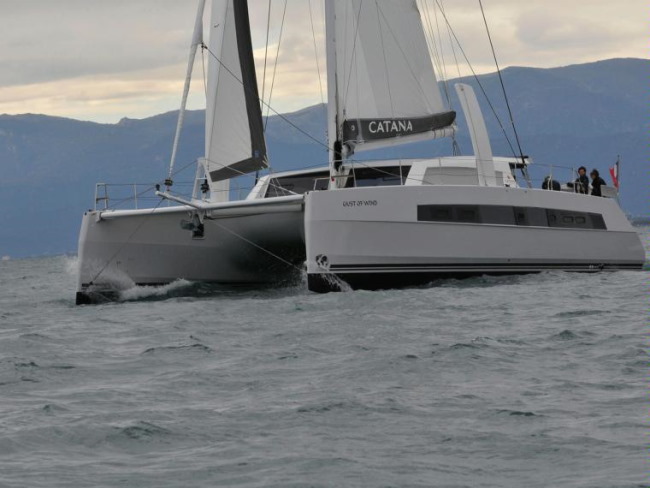
In 2013, the Catana 59 was designed by Marc Lombard working alongside Catana’s in-house team, and it caused something of a stir, as the 47 and 42-foot models were the only remaining Christophe Barreau designs.
The design philosophy later extended to the 53 and a modernised stretched version: the 62.
She has lovely lines: a high freeboard, good bridge deck clearance, and a generous sail plan. The new muscly look is an indicator of this cat’s performance.
Catana 70 (2012)
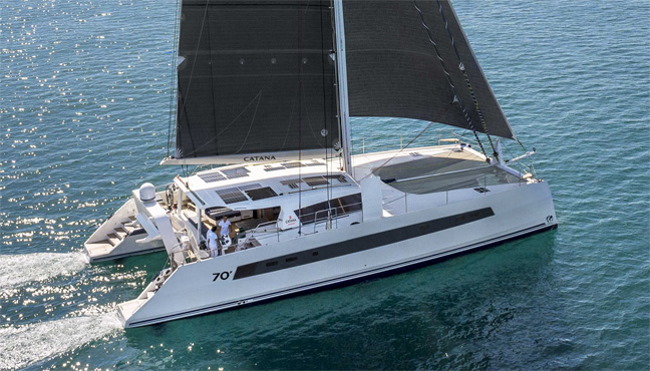
A very sleek design for such a large yacht, the 70 was designed by Marc Lombard. After this, Catana brought the design in-house, but you can still see Lombard’s influence in the later designs such as the 53. He was retained as a consultant.
Catana 55 (2013)
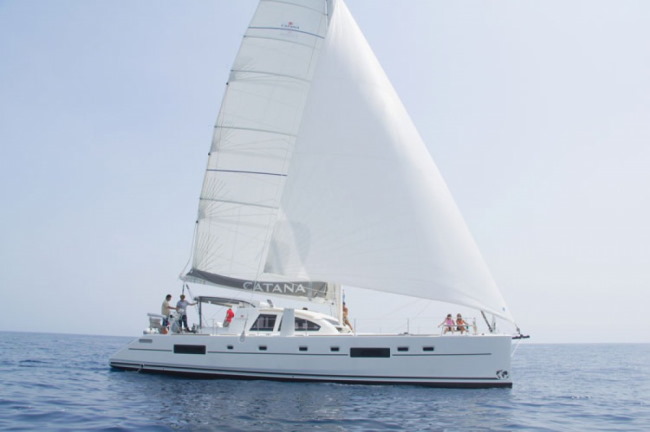
Image Credit: Curie via Samboat
Catana 62 (2016)
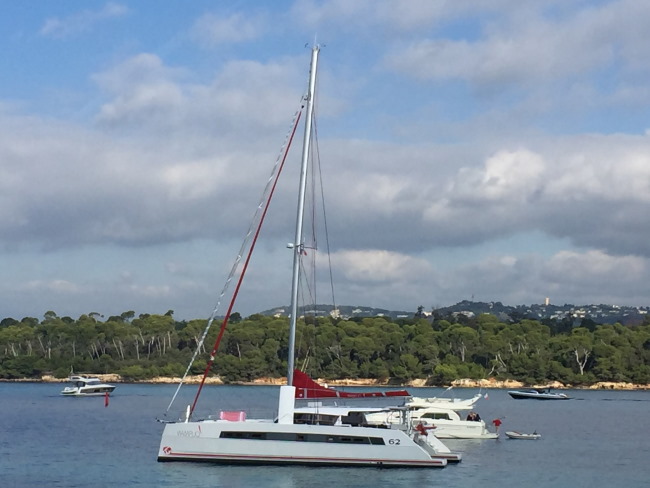 Photo Credit: Manuel Gubbins. Hull #1: Wampuo.
Photo Credit: Manuel Gubbins. Hull #1: Wampuo.
The big sister to the 53, the 62 evolved from the earlier 59.
With its maxi hulls with inverted bows, foil-type daggerboards, Carbon Infusion and Twaron Impact technology, the C62 is one of the safest catamarans in its class.
Catana 53 (2017)
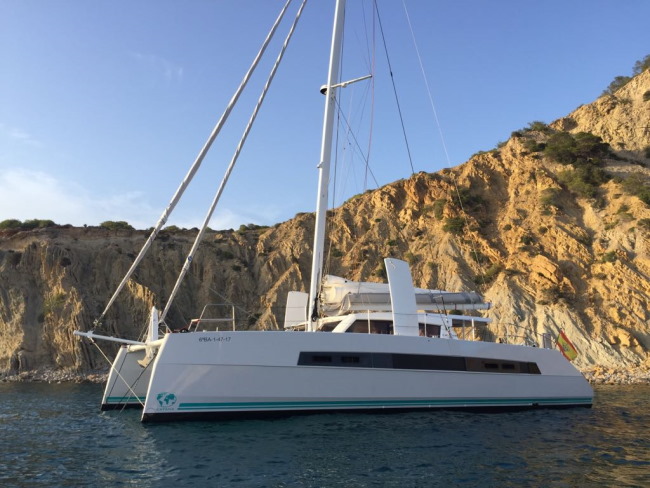 Image credit: Catamaran Center.
Image credit: Catamaran Center.
The 53 is the only remaining model in Catana’s current line-up apart from the Ocean Class. We are hoping that they will get back to widening the range in the future, but it looks like they will focus on the 50 Ocean Class and the Bali brand for now.
The living space is huge thanks to those twin aft helms and the Open design between the saloon and cockpit.
This model was awarded “Multihull of the Year” by Cruising World in 2017.
Read our Catana 53 review in the performance cats section.
We also have an Owner’s Review on this cat which is well worth a read. Thanks to Rowan on PolePole.
Ocean Class (2022)
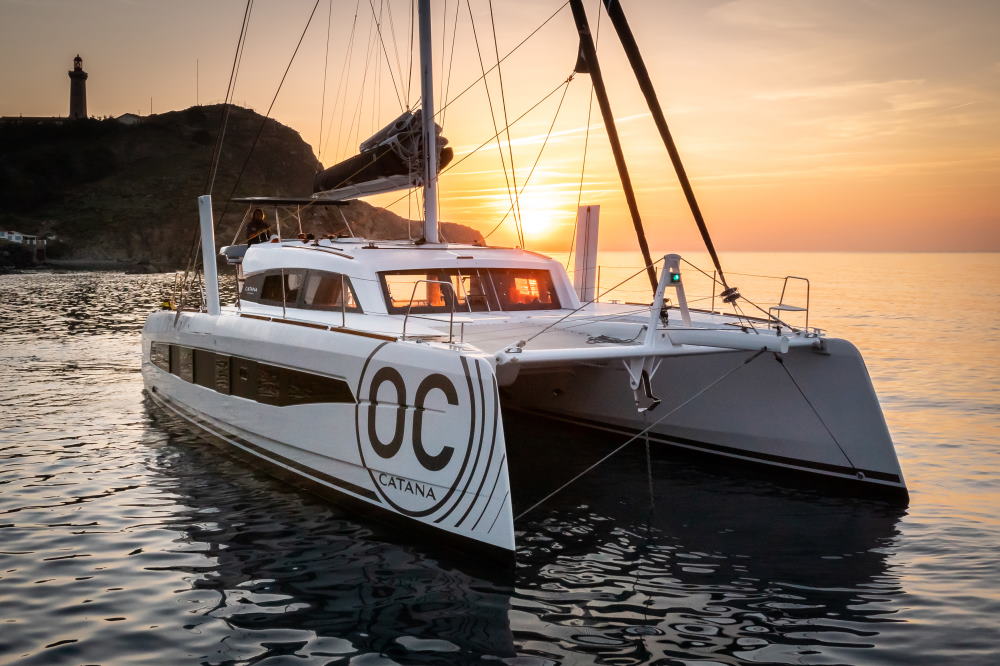
The new Ocean Class is a 52-footer. This design is quite a departure for Catana as she has a single raised bulkhead helm. She’s a solid-looking design.
We first saw this model at La Grande Motte in 2022. Read our Catana Ocean Class review.
Thanks
A big thank you to the members of the Catana Catamarans Owner’s Group on Facebook for helping with this history.
Other Brands
If you enjoyed this page, take a look at our other catamaran brand histories:
Balance
Dazcat
Fountaine Pajot
Gunboat
HH
Kinetic
Lagoon
Leopard
Marsaudon Composites
Nautitech
Outremer
Privilege
Prout
Sunreef
Catana Reviews
Showing all 6 results
Showing all 6 results

